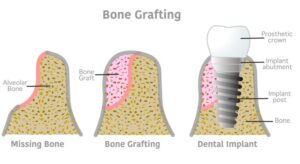
Dental implants are prosthetic tooth roots that get placed in the jawbone; they can rebuild lost teeth in their entirety! In order for them to be successful, however, they need to have a strong base of support within your body. To make sure that your implants have the foundation they need, your dentist might determine that you need bone grafting. What does a bone graft accomplish, and how can you tell if you need one? This blog post explains.
What Does a Bone Graft Accomplish?
A bone graft is a surgical procedure during which your dentist or a specialist will add bone material to your jawbone in order to strengthen and enlarge it. The material may be synthetic or natural bone, and it may be harvested from your own body or other sources.
Once the graft is in place, your body should start to integrate it. This should result in a stronger and healthier jawbone that can serve as a sturdy home for your dental implants. In contrast, without a bone graft, it would be more likely that your implants would become loose or fail altogether.
How to Tell if You Need a Bone Graft
Not all patients need a bone graft before getting dental implants. Your dentist will examine your mouth and take some images of your jawbone to determine if it is healthy enough and large enough to support your new teeth.
The need for a bone graft is more likely if:
- A significant amount of time has passed since you lost your natural teeth. (The jawbone tends to shrink over time after extractions.)
- Your jawbone is naturally small or weak.
- You previously suffered an injury to your jawbone.
- Advanced gum disease damaged your bone.
What to Expect with a Bone Graft
Sometimes, a bone graft can be performed at the same time as dental implant placement. In other instances, there is a waiting period of a few months between the two procedures. There are also a range of different types of bone grafts. Your dentist will walk you through the details of your unique treatment plan.
In any case, you can expect your care team to make you comfortable during your procedure. Although you will experience some soreness afterward, your soft oral tissues should heal within just a few weeks. It can take much longer for the bone to heal and integrate the grafted material, but you should be pain-free for the majority of that time.
Bone grafting can help you enjoy successful dental implant treatment! Talk to your dentist to learn more about this procedure and its role in tooth replacement.
Meet the Practice
Dr. Clark Julian and our Mesa, AZ, team proudly provide start-to-finish dental implant services. We used advanced technology and sedation to make the entire experience as comfortable as possible. If you are interested in what it would take to rebuild your lost teeth, we would be pleased to consult with you. Contact our office at 480-482-7178.
